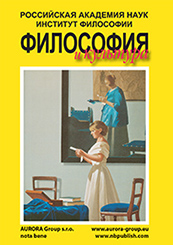Editor-in-Chief's column
Reference:
Gurevich, P. S. (2014). Theodor Adorno’s ‘Sad Science’. Philosophy and Culture, 3, 315–318. https://en.nbpublish.com/library_read_article.php?id=64162
Abstract:
The present article is devoted to the philosophy and creative work by Theodor Adorno. In 2011 the book ‘The
Jargon of Authenticity’ written by the leading member of the Frankfurt School was published. The book was first published
in Germany half a century ago and today the author of the present article tries to reveal the nature of Theodor Adorno’s
‘sad science’. The book presents a philosophical tradition named the ‘critical theory of ideology’. Adorno shows that
ideology exists in particular forms that are called by intelligentsia and others by common jargon terms. These terms are
used in teaching and at people’s universities and youth unions. Ideological jargon is standardized. However, it is also the
language that seems to be ‘not for everyone’. People tend to be attracted to the feeling of belonging to these or those
intellectual traditions rather than to the meaning of terms.
In his research article the author uses different methods. First of all, he uses the historical method that allows him to
describe the creative work by Theodor Adorno as a complete phenomenon. At the same time, the author also uses the
phenomenological method that allows him to reveal the deep philosophical core of Adorno’s works. Hermeneutic method
also allows to analyze the above mentioned form of ideology that reveals itself in hidden forms.
The novelty of the article is the description of Adorno’s works as the ‘sad science’. Criticism of established forms of social
communication implies the proof that these forms of social communication are void. The author of the article shows
that jargon has a rather dynamic nature and reflects a rather negative spirit of those times as just serving certain social
purposes.
Keywords:
philosophy, social studies, esthetics, culture, Adorno, dialectics, ideology, power, jargon, embodiment.
Methodology of philosophical learning
Reference:
Rozin, V. M. (2014). Formation of the Ancient Thinking Methodological, Phenomenological, Technological and Institutional Aspects. Philosophy and Culture, 3, 319–328. https://en.nbpublish.com/library_read_article.php?id=64163
Abstract:
The author of the article offers a new outlook on the process of ancient thinking formation. The novelty of
the research is that the author tries to show that from the very beginning, thinking has had both methodological
and phenomenological aspect, although the latter were not understood specifically due to the fact that philosophical
disciplines were formed only in the culture of the Early Modern Period. Moreover, the author of the present article
suggests that we should view Aristotle’s rules and thinking categories as the creation of some kind of the intellectual
technology as well as the first attempt to design the institution of thinking. The author substantiates his new views on
ancient thinking based on the analysis of the genesis and development of ancient philosophy as well as the description
Parmenides’, Plato’s and Aristotle’s views. Noteworthy that the author shows that the concept of thinking introduced by
Parmenides was nothing else but the image of the intellectual path and discussion of certain criteria showing whether
the path was correct or not. After him Plato and Aristotle discussed how to put the idea into life and convey the solution
(method) to others. Solution of the aforesaid problems results in creation of the concept of the ancient thinking.
Keywords:
cogitation (thinking), methodology, phenomenology, technology, institution, reasoning, knowledge, personality, rules, categories.
History of ideas and teachings
Reference:
Gaynutdinov, T. R. (2014). Cartesian Note: The Problem of the Physical in Descartes Philosophy. Philosophy and Culture, 3, 329–338. https://en.nbpublish.com/library_read_article.php?id=64164
Abstract:
The article is devoted to the problem of the physical in Rene Descartes’ philosophy and successively views the
process of formation of the cartographic description of the physical. The cartographic description of the physical was
first used by Descartes in the XXth century and then developed by Gilles Deleuze and Jean-Luc Nancy as well as a number
of other philosophers. The purpose of the present research article is to define the focal points of the body functioning
in Cartesianism, some schemes of the body field and its literal machinery (Descartes’ ‘body-machine’). However, the
author of the present article deviates from the dualistic interpretation of the physical in Cartesian philosophy. The author
appeals to the metaphoric structure of Descartes’ texts and focuses on the analysis of particular figures of speech and
style used by Descartes. The author views the relation between the internal and the external in a different light and shows
that Descartes never limited the internal only to the inside of the body. Moreover, the author of the article shows that in Cartesianism the body functions mostly as the object of loss and this causes radicalization of the body: there is no object
more significant than the one that has been lost. ‘Cartesian’ body is always functioning and organically redundant yet
this redundancy reflects the radical emptiness of the body. This physical discourse where discussions about the body
inevitably touch upon the ‘foreignness’ of the body is called ‘Cartesian note’ by the author.
Keywords:
Rene Descartes, cartesianism, body, the physical, metaphor, anatomy, Cartesian note, physical cartography, dualism, Jean-Luc Nancy.
Picture of the world in natural science
Reference:
Yurkevich, E. V., Leschev, S. V. (2014). Convergent Causality: Information Interactions in Biological Systems. Philosophy and Culture, 3, 339–349. https://en.nbpublish.com/library_read_article.php?id=64165
Abstract:
The article is devoted to epistemological and ontological aspects of the problem of biological causality originating
from a broad convergent interpretation of the nature of information and interaction between living objects. The authors
focus on cognitive differentiations that relate to the strategies of perceiving and presenting information. The authors also
describe particular features of information influences at the level of formation of causal connections between the source
and the receiver (due to the non-objective nature of information media) and the process of perceiving messages. The
results of researching the biogenesis of the ‘parasite-host’ system are generalized based on the example where parasites
are bacterial nanoforms and the host is the epithelium of fish.
Based on methodological approaches to construction of nano-bio-info-cognitive technologies, the authors of the article
view a number of general issues of determinism as well as particular issues of formation of the cause-and-effect relations.
This new interpretation of the framework of categories created the grounds for further determination of special features
of communication causality. The authors of the article also try to compare the cause-and-effect patterns in the material
world to their information equivalent. By using the three-level model of information influence offered by the authors,
they define special features of the biogenesis in the ‘parasite-host’ system. The two-side nature of the causal connections
is viewed as the most important condition for sustainable genesis of biological objects.
Keywords:
convergent nature of information, model of information interactions, nano-bio-info-cognitive technologies, cause-and-effect relations, biological causality, colony of parasite, parasite-host, logic of the purposes of a living object, system adaptation, biogenesis sustainability.
Social philosophy
Reference:
Ismailov, N. O. (2014). John Rawls’ Theory of Justice. Philosophy and Culture, 3, 350–361. https://en.nbpublish.com/library_read_article.php?id=64166
Abstract:
The author of the present article analyzes the main ideas shared by John Rawls in his book ‘A Theory of Justice’.
John Rawl was one of the most famous modern philosophers who studied justice. The author of the article also studies
the principles of distributive justice. The author also provides a brief analysis of the main ideas and conclusions made
by Rawls in his later theory of political liberalism. The author views Rawls’ views as reflecting the reality of the modern
society and tries to find particular points in Rawls’ theory that could have been used for the implementation of the
principles of justice in the modern society. The author studies the problem of justice from the point of view of the unity
of all spheres of social life, causal and functional relations and interconnection of needs, interests and values. Rawls’
theory is viewed as the ‘contract theory’. Theoretical ground of Rawls’ theory of justice is the deontological liberalism.
Rawls’ theory has certain advantages, for example, his recommended measures to achieve the social consent, and
disadvantages: the author does not see any interdependence between the must and the benefit, needs, interests and
values or relation between the main spheres of social life and economic and ideological relations in Rawls’ studies.
Keywords:
justice, freedom, equality, deontology, the must, needs, interests, values, benefit, social contract.
Social dynamics
Reference:
Korolev, S. A. (2014). ‘Norman Ferment’ in Terms of the Concept of Pseudomorphic Development of Russia. Philosophy and Culture, 3, 362–382. https://en.nbpublish.com/library_read_article.php?id=64167
Abstract:
The author of the article offers his concept of pseudomorphic development of Russia and views the question
about the interaction and interdependence between governmental patterns brought by the Varangians to the lands
inhabited by the Slavs and Ugro-Finns at the second half of the IXth century. The author raises a question about the role of
Norman (the Varangians) in formation and development of the Russian state after Rurik came to Novgorod and after Kiev was conquered by his successor Oleg. The author also studies the relation between the allochtonous and autochtonous
information of the Old Russian state, in particular, relation between the great and tribal knyazhes, veche and the new
European-like knyazh power. The author raises a question about to what degree processes caused by the coming of the
Norman (Varangians) could have been viewed as a pseudomorphosis and the ground and condition for Christianization of
Russia (which, according to the author, was a typical pseudomorphic process). The author’s theory about pseudomorphic
historical development of Russia is based on a famous theory offered by Oswald Spengler). The author reviews Spengler’s
theory and views pseudomorphosis not only as a certain stage or form of development, in particular, development of
Russia, but also a certain type of development. As for concrete historical examples, the author bases on a wide range of
historical works written by both famous Russian historians (K. Kavelin, V. Klyuchevsky, S. Platonov and S. Soloviev) and
Soviet researchers (V. Kobrin, A. Novoseltsev, V. Puzanov, B. Rybakov, M. Sverdlov, A. Tolochko, F. Uspensky, I. Froyanov,
A. Yurganov, V. Yanin and others).
Based on the results his research, the author concludes that the Norman brought some kind of a new cover for the life of
the Slavs and Ugro-Finns. From this point of view, we can conclude that ‘normanization’ of Russia was a pseudomorphosis
that was also typical, for instance, for the epoch of Peter the First. Coming of the Varganian knyazhes was mostly a
‘ferment’ triggering the development of Russia in a certain direction. ‘Normanization’ of Russia created a certain type of
government and that was the only form of government under which Christianity could exist as a state religion but not just
a local cult. In other words, without the coming of the Varangians and triggering of certain processes in the government,
Russia would not have been ready to adopt Christianity at the end of the Xth century.
Keywords:
pseudomorphosis, Norman, the Varangians, Rurik, mythologization, conquest, Knyazh, veche, Novgorod, Kievan Rus.
Characteristics of society
Reference:
Popov, E. A. (2014). The Role of Social Studies in the Research of the ‘Culturally Prepared’ Society. Philosophy and Culture, 3, 383–390. https://en.nbpublish.com/library_read_article.php?id=64168
Abstract:
Today society is the target of different social and humanitarian researches studying this or that aspect of social
development. Meanwhile, science studies different types of societies and defines their special features and regular patters
of functioning. The author of the present research article focuses o the cultural nature of the society and problems of
socio-cultural determination of the social development. The main question of the article is ‘If there is a society, then
what kind of society is it?’. The author offers the following answer to this question: this is the type of ‘culturally prepared’
society that is limited only to social functions and meanings. The systems approach to studying socio-cultural phenomena
and processes allow to trace the relation between society and culture.
The author of the article also describes different types of society and social development from the point of view of
their ‘sociality’ and socio-cultural dynamics. The author stresses out that social determination cannot be the preferred
direction of the development of societies. The main trend in their development should be connected with the processes
of cultural dynamics. The main conclusion is that the modern reality forms the ‘culturally prepared’ type of society and
the type of society that is being formed in the process of exchange of cultural meanings and codes between different
generations of culture bearers.
Keywords:
society, culture, multiculturalism, civil society, community, cultural dynamics socio-cultural processes, social studies of life, cultural system, social development.
Philosophy of history
Reference:
Demin, I. V. (2014). Comparative Analysis of Interpretations of Historical Experience by Frank Ankersmit and Hans Gadamer. Philosophy and Culture, 3, 391–400. https://en.nbpublish.com/library_read_article.php?id=64169
Abstract:
The author of the article compares the two different concepts of historical experience offered by Frank Aknersmit
and Hans Gadamer. The interest for the phenomenon of historical experience as well as the narrative is one of the most
typical features of the modern post-metaphysical philosophy of history. The author of the article pays special attention to
the problem of the relation between historical experience and historical narrative. Gadamer’s and Ankersmit’s theories
are viewed as the alternative and competing strategies in the sphere of the post-metaphysical philosophy of history. The
corner stone in these two theories is the interpretation of the correspondence between historical experience and the
language of historical narrative. In his research the author used hermeneutic methods, historical method and historicalcomparative
method as well as the problem oriented analysis. Gadamer focused on the positive role of traditions and language as the ontological conditions of historical experience. Gadamer understood historical experience as the
experience of appealing to traditions and their interpretation. Ankersmit focused on the negative role of the language.
Ankersmit related the authenticity of historical experience to the ‘release from the language jail’. According to the author,
the language of history description, on one hand, inevitably distorts the authentic (pre-linguistic) historical experience
and, on the other hand, represents the only possible form of its expression.
Keywords:
history, historicity, historical experience, language, historical narrative, nostalgia, philosophical hermeneutics, tradition, Gadamer, Ankersmit.
Theological foundations of being
Reference:
Lobanov, S. V. (2014). The Idea of the Absolute in the Two Monistic Paradigms: Shankara’s Advaita and Abhinavagupta’s Para-Advaita. Philosophy and Culture, 3, 401–412. https://en.nbpublish.com/library_read_article.php?id=64170
Abstract:
The subject of the present research article is the Advaita Vedanta and Kashmir Shaivism as the two main
monistic systems of the Indian philosophy introduced by Shankara and Abhinavagupta respectively. Philsophical and
religious (mystical) monism was the paradigm in their works. The author of the article compares the two paradigms
of monism, Shankara’s advaita (non-duality) and Abhinavagupta’s para-advaita (the highest level of non-duality) by
comaring their idea of the Absolute. The author’s approach allows to describe the understudied philosophy of Kashmir
Shaivism in comparison with the most famous and the best studied system of the Indian thought. The author conducts
his comparison based on Sanskrit sources in both monistic systems including expressions and arguments used by the
two great representatives of monism. In particular, the author analyzes Shankara’s and Abhinavagupta’s views on the
Absolute as the central concept in their philosophical doctrines represented in the two different monistic paradigms as
the ‘static’ or inactive Absolute (Brahman) of Advaita and the ‘dynamic’ creative Absolute (Anuttara, Shiva) of Para-
Advaita. The topic raised by the author o the article is quite perspective and important for Russian studies of Indian
philosophy in particular and history of philosophy in general. The author manages to cover the annoying gap and provide
texts in philosophy of Kashmir Shaivism as the most poorly studied branch of Indian philosophy today. Growing interest
of the West towards this branch of Indian philosophy encouraged the growth of attention of Indian researchers, too.
Meanwhile, in Russia literature on Kashmir Shaivism is mostly translated from English and there is no researches or
thesis works written on the matter besides the thesis research by N. Isaeva. A few articles and translations of extracts
from Sanskrit sources do not cover the gap, either. The author of the present article appeals to Sanskrit sources, most of
them have never been translated into Russian, as well as the Western and Indian researches. The author introduces new
concepts, Sanskrit terms and other information in Russian science. The article will be of interest not only for those who
study history of philosophy, but also for those who are involved in cultural research, religious studies, Indian studies and
interdisciplinary research.
Keywords:
monism, Indian philosophy, Shankara, Abhinavagupta, Advaita Vedanta, advaita, para-advaita, Kashmir Shaivism, Vedanta, Pratyabhijña.
Hermeneutics
Reference:
Chesnov, Ya. V. (2014). Hermeneutics of Knowledge in National Culture (Special Theory of Anthropocenosis). Philosophy and Culture, 3, 413–425. https://en.nbpublish.com/library_read_article.php?id=64171
Abstract:
The author of the article describes the process of anthropocenosis by the means of national culture in order to
define the role of the two forms of primordial knowledge, locus knowledge and itinerary knowledge. Special attention
is paid to the phenomenon of the name (identity). It turns out that this phenomenon lies in the basis of both the archaic
thinking and modern scientific thinking. A particular case of naming is silence. Silence characterizes national culture
more than speaking. Silence is associated with a special type of primordial knowledge that structures the process
of anthropocenosis. Research methodology includes the hermeneutic method that involves exposition (fixation –
description), understanding and interpretation and finally, explanation (in our case, determination of anthropocenosis).
Modern humanitarian theory usually involves analysis of a macro community like state institution, civilization and etc.
It does not touch upon the intimate human world while the author of the present article uses it as the main focus of
hermeneutic analysis. At the end of the article the author makes quite an unexpected conclusion: the structure of the
archaic knowledge is identical to the modern structure of science.
Keywords:
anthropocenosis, national culture, knowledge, archaic character, community of practice, the Golden Age, ethnos, customs, conscience, name (identity).
Myths and modern mythologies
Reference:
Maydanov, A. S. (2014). The Logic of Mythological Thinking. Philosophy and Culture, 3, 426–441. https://en.nbpublish.com/library_read_article.php?id=64172
Abstract:
The author of the article tries to answer the question if we can talk about the logic of mythological thinking and
if we can, then what the logic of mythological thinking is all about? The author proves that we can’t apply the term ‘logic’
as it was understood by Aristotle here. The author also describes how the views on the logic of mythological thinking have
been developing with time and defines the most promising points of view for his study. He describes the consciousness of
archaic people and finds out that special features of their consciousness were conditioned by particular forms and rules
of thinking. In his study the author uses the evolutionary approach, comparison methods, generalization method and the
method of new typification. The author establishes that the archaic thinking was based on certain principles and specific
paradigms. As a consequence, mythological thinking is a special type of thinking activity operating a great number of
unique methods and techniques. Under the influence of these factors, the process of myth creation has appeared to be a
rather determined, theological, efficient and psychologically and esthetically efficient.
Keywords:
myth, consciousness, image, concept, reality, determinants, opposition, schemes, paradigms, correlation.
 This work is licensed under a Creative Commons Attribution-NonCommercial 4.0 International License.
This work is licensed under a Creative Commons Attribution-NonCommercial 4.0 International License.
 Eng
Eng












 © 1998 – 2025 Nota Bene. Publishing Technologies. NB-Media Ltd.
© 1998 – 2025 Nota Bene. Publishing Technologies. NB-Media Ltd.




